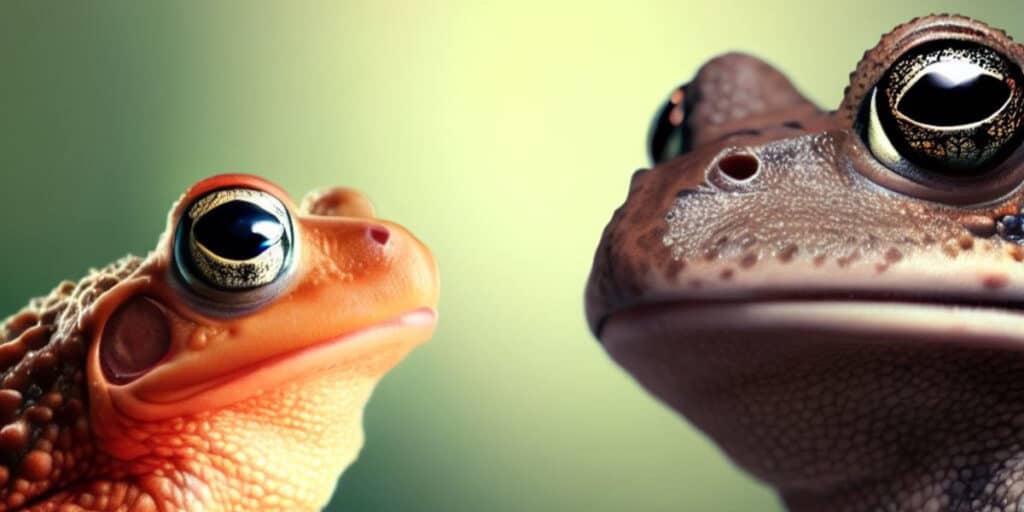Introduction
Frogs and toads are both amphibians, which means they are cold-blooded animals that can live both on land and in water. They belong to the order Anura, which means “without tail”. However, not all amphibians in this order are called frogs or toads. In fact, there is no scientific basis for these labels, as they are not separate taxonomic groups. All toads are actually frogs, but not all frogs are toads. So, how can we tell them apart? In this article, we will explore the similarities and differences between frogs and toads, based on their physical features, breeding habits, diet, and behavior.
Similarities Between Frogs and Toads
Frogs and toads have similar bodies with four legs, a flat head, and a long tongue used for catching prey. They have moist skin that helps them breathe through their skin as well as their lungs. They also have glands on their skin that secrete substances that can be toxic, foul-smelling, or sticky to deter predators. Both frogs and toads undergo metamorphosis, which means they change from eggs to tadpoles to adults. They also have similar diets and feeding habits, as they mostly eat insects, worms, snails, and other small animals.
Differences Between Frogs and Toads
Despite their similarities, frogs and toads have some distinct differences that can help us identify them. Here are some of the main differences between frogs and toads:
Skin
One of the most obvious differences between frogs and toads is their skin texture. Frogs have smooth and moist skin that looks shiny or slimy. This is because they secrete a mucus that keeps their skin from drying out and protects them from infections. Toads have dry and rough skin that looks warty or bumpy. This is because they have more glands on their skin that produce toxins or poisons that make them unpalatable to predators.
Teeth
Another difference between frogs and toads is their teeth. Frogs have small teeth on their upper jaw that help them hold their prey before swallowing it whole. Toads do not have any teeth at all, so they rely on their tongue and mouth muscles to catch and swallow their food.
Legs
The length of the hind legs is another difference between frogs and toads. Frogs have longer hind legs than their head and body, which give them the ability to leap far over ground and swim fast through water. Toads have shorter hind legs than their head and body, which make them look squat and round. They move by taking small hops or crawling on the ground.
Eyes
The shape and position of the eyes are another difference between frogs and toads. Frogs have round eyes that bulge out of their head, which give them a wide range of vision. They also have a transparent membrane called a nictitating membrane that covers their eyes when they are underwater or on land. Toads have oval eyes that are more sunken into their head, which limit their vision. They do not have a nictitating membrane, but they can close their eyes completely when they are threatened or sleeping.
Eggs
The appearance and arrangement of the eggs are another difference between frogs and toads. Frogs lay their eggs in clusters or masses that float on the surface of the water or attach to aquatic plants. The eggs are covered by a jelly-like substance that protects them from drying out or being eaten by predators. Toads lay their eggs in strings or chains that sink to the bottom of the water or wrap around plants or rocks. The eggs are covered by a thin membrane that allows them to absorb oxygen from the water.
Habitat and Behavior
The habitat and behavior of frogs and toads are another difference between them. Frogs prefer moist habitats like ponds, lakes, streams, swamps, or marshes, where they can find water easily. They are mostly active at night, when they hunt for food or mate by making loud croaking sounds. Toads prefer drier habitats like fields, woods, gardens, or deserts, where they can find shelter under rocks or logs. They are mostly active during the day, when they search for food or burrow into the soil to avoid heat or cold.
Conclusion
Frogs and toads are both fascinating amphibians that share many similarities but also have many differences. By looking at their skin, teeth, legs, eyes, eggs, habitat, and behavior, we can learn to distinguish them and appreciate their diversity. Whether you encounter a frog or a toad on your next walk through the woods, remember that they are both important members of the ecosystem and deserve our respect and protection.




